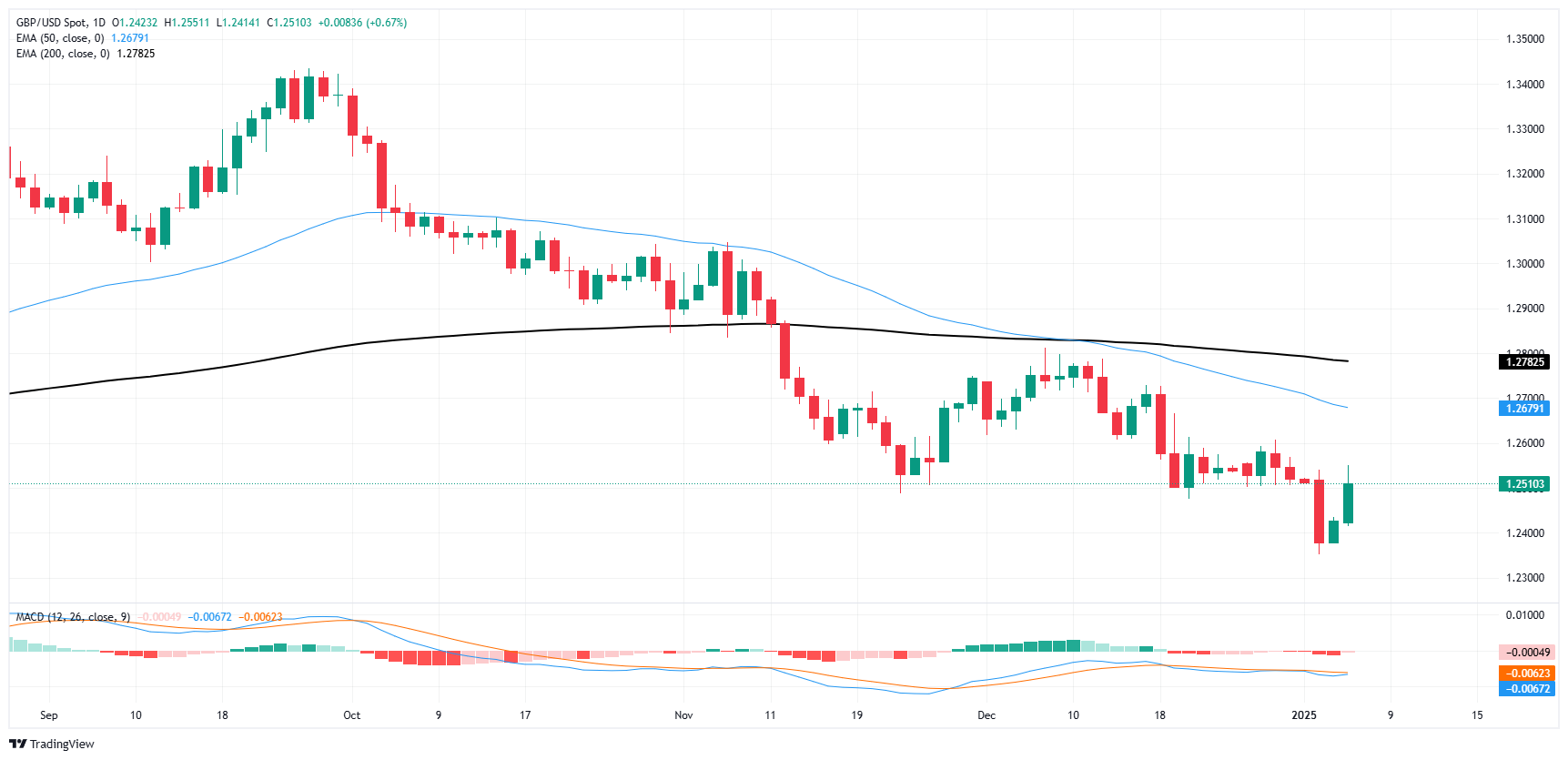- GBP/USD caught a bid on Monday, rising 0.7%.
- PMI figures came in softer on both sides of the Atlantic.
- Easing Greenback flows gave Cable a chance to catch its breath.
GBP/USD extended into its second day of gains in a row, kicking off the new trading week gaining seven-tenths of one percent and dragging bids back above the 1.2500 handle after last week’s bearish plunge below 1.2400. Purchasing Managers Index (PMI) figures missed the mark on both the UK and US sides. However, a general milieu of rising risk appetite kept safe-haven flows into the Greenback at bay.
UK PMI figures for December entirely missed the mark, printing below Wall Street forecasts and falling back but remaining above the 50.0 watermark for contraction expectations. The Composite PMI in particular fell to a 13-month low, easing to 50.4 from the expected hold at 50.5.
Final US S&P Global PMI figures somewhat missed the mark on Monday, with the Composite and Services PMIs for December both climbing from one month to the next, albeit less than analysts expected. Both indicators saw a slight downward revision from their preliminary prints, but still gained ground as the US economy churns on.
The key print for the midweek window will be Tuesday’s US ISM Services PMI for December. Median market forecasts are expecting an upswing to 53.0 from the previous month’s 52.1. Friday’s Nonfarm Payrolls (NFP) print will cast a long shadow over markets this week as investors anticipate a goldilocks print that will help push the Federal Reserve (Fed) toward more rate cuts, but not too weak or strong toward either side.
GBP/USD price forecast
GBP/USD has eased into a two-day rally, a welcome technical turn after the pair plunged to fresh nine-month lows last week below the 1.2400 handle. While selling pressure still has eyes set on the major 1.2000 price level, an exhaustion play could be on the cards as buyers try to muscle price action back up to the 50-day Exponential Moving Average (EMA) falling through the 1.2700 handle.
GBP/USD daily chart
Pound Sterling FAQs
The Pound Sterling (GBP) is the oldest currency in the world (886 AD) and the official currency of the United Kingdom. It is the fourth most traded unit for foreign exchange (FX) in the world, accounting for 12% of all transactions, averaging $630 billion a day, according to 2022 data. Its key trading pairs are GBP/USD, also known as ‘Cable’, which accounts for 11% of FX, GBP/JPY, or the ‘Dragon’ as it is known by traders (3%), and EUR/GBP (2%). The Pound Sterling is issued by the Bank of England (BoE).
The single most important factor influencing the value of the Pound Sterling is monetary policy decided by the Bank of England. The BoE bases its decisions on whether it has achieved its primary goal of “price stability” – a steady inflation rate of around 2%. Its primary tool for achieving this is the adjustment of interest rates. When inflation is too high, the BoE will try to rein it in by raising interest rates, making it more expensive for people and businesses to access credit. This is generally positive for GBP, as higher interest rates make the UK a more attractive place for global investors to park their money. When inflation falls too low it is a sign economic growth is slowing. In this scenario, the BoE will consider lowering interest rates to cheapen credit so businesses will borrow more to invest in growth-generating projects.
Data releases gauge the health of the economy and can impact the value of the Pound Sterling. Indicators such as GDP, Manufacturing and Services PMIs, and employment can all influence the direction of the GBP. A strong economy is good for Sterling. Not only does it attract more foreign investment but it may encourage the BoE to put up interest rates, which will directly strengthen GBP. Otherwise, if economic data is weak, the Pound Sterling is likely to fall.
Another significant data release for the Pound Sterling is the Trade Balance. This indicator measures the difference between what a country earns from its exports and what it spends on imports over a given period. If a country produces highly sought-after exports, its currency will benefit purely from the extra demand created from foreign buyers seeking to purchase these goods. Therefore, a positive net Trade Balance strengthens a currency and vice versa for a negative balance.
Information on these pages contains forward-looking statements that involve risks and uncertainties. Markets and instruments profiled on this page are for informational purposes only and should not in any way come across as a recommendation to buy or sell in these assets. You should do your own thorough research before making any investment decisions. FXStreet does not in any way guarantee that this information is free from mistakes, errors, or material misstatements. It also does not guarantee that this information is of a timely nature. Investing in Open Markets involves a great deal of risk, including the loss of all or a portion of your investment, as well as emotional distress. All risks, losses and costs associated with investing, including total loss of principal, are your responsibility. The views and opinions expressed in this article are those of the authors and do not necessarily reflect the official policy or position of FXStreet nor its advertisers. The author will not be held responsible for information that is found at the end of links posted on this page.
If not otherwise explicitly mentioned in the body of the article, at the time of writing, the author has no position in any stock mentioned in this article and no business relationship with any company mentioned. The author has not received compensation for writing this article, other than from FXStreet.
FXStreet and the author do not provide personalized recommendations. The author makes no representations as to the accuracy, completeness, or suitability of this information. FXStreet and the author will not be liable for any errors, omissions or any losses, injuries or damages arising from this information and its display or use. Errors and omissions excepted.
The author and FXStreet are not registered investment advisors and nothing in this article is intended to be investment advice.
Recommended content
Editors’ Picks

AUD/USD ticks lower toward 0.6200 after Australian Nov inflation data
AUD/USD remains pressured toward 0.6200 following the release of Australian consumer inflation figures, which showed a slowing in the trimmed mean annual CPI , boosting the odds for an April RBA rate cut. Meanwhile, US-China trade war fears and a softer risk tone add to the weight on the pair.

USD/JPY steadies at around 158.00, Fed Minutes awaited
USD/JPY holds steady at atound the 158.00 mark early Wednesday amid uncertainty over further BoJ rate hikes. Further, the Fed's hawkish shift, the recent surge in the US bond yields and a bullish US Dollar support the currency pair, though Trump trade risks cap gains. US ADP data and Fed Minutes eyed.

Gold price consolidates around $2,650 area as traders await FOMC Minutes
Gold price struggles to attract buyers amid the Fed’s hawkish stance and elevated US bond yields. Trade war fears and geopolitical risks lend support to the XAU/USD amid a modest USD downtick. Investors look to the US macro data and FOMC meeting Minutes for some meaningful impetus.

Top 3 Price Prediction Bitcoin, Ethereum, Ripple: Over $560 million in liquidation
Bitcoin hovers around $97,000 on Wednesday after declining more than 5% the previous day. Ethereum and Ripple follow in BTC’s footsteps and decline 8.3% and 6.15% respectively.

Five fundamentals for the week: Nonfarm Payrolls to keep traders on edge in first full week of 2025 Premium
Did the US economy enjoy a strong finish to 2024? That is the question in the first full week of trading in 2025. The all-important NFP stand out, but a look at the Federal Reserve and the Chinese economy is also of interest.

Best Forex Brokers with Low Spreads
VERIFIED Low spreads are crucial for reducing trading costs. Explore top Forex brokers offering competitive spreads and high leverage. Compare options for EUR/USD, GBP/USD, USD/JPY, and Gold.